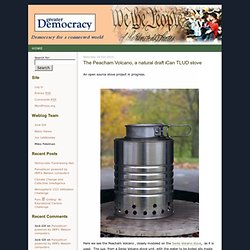

Greater Democracy » Blog Archive » The Peacham Volcano, a natural draft iCan TLUD stove. An open source stove project in progress.

Here we see the Peacham Volcano , closely modeled on the Swiss Volcano stove, as it is used. The cup, from a Swiss Volcano stove unit, with the water to be boiled sits inside the iCan made from a single pineapple juice can. The iCan, in turn, sits on two angle irons inside a three pound Costco coffee can. This outer can has four functions: 1] wind shield; 2] insulation and heat retention; 3] modulates the air flow into the system as the size and number of holes varies; 4] safety — as the bottom is intact, it catches any stray hot coals. With an ambient temperature of about 6.5 degrees C and water of about the same temperature, on a windy and blustery New England Fall day, the Peacham Vulcano was able to boil 400 ml of water in just under 10 minutes.
On the other hand, the open source Peacham Volcano stove, excepting the cup with tapered sides, costs $0.00. Greater Democracy » Blog Archive » Everyman’s gas well in a can, a distributed solution. Yesterday, I took a novel approach to converting short cycle organic carbon, a product of photosynthesis, into long cycle elemental carbon, biochar, with a one quart retort.

It gave a very clean result with the retort clean as a whistle at the end. No tarry residues on the inside of the lid or any place else. The retort was loaded with about 1 quart of wood pellets and yielded about 16 oz of char — by volume. To read how this becomes “Everyman’s gas well in a can, a distributed solution”, please follow the link below: Everyman’s gas well in a can, a distributed solution .pdf The illustrations and text in the PDF will allow you to make your own gas well in a can easily, quickly, and safely. If you use this in a science class, please let me know. Note: For a good resource on biochar, I recommend the Biochar Farms site. Note 2: ZeroPoint Clean Tech is well on the way to commercializing the use of “Manufactured Gas” made from biomass — NOT coal. Author: Jock Gill. Pyrolysis: Creating Carbon Negative Energy.
Skip to main content Air Date This show currently has no upcoming air dates.

Click the "Request Air Date" button below if you would like us to re-air this show. Request Air Date Pyrolysis: Creating Carbon Negative Energy STEM Education: Pyrolysis: Creating Carbon Negative Energy TAGS: Carbon Negative, engaging youth, renewable energy Embed Home Pyrolysis: Creating Carbon Negative Energy Show: Pyrolysis: Creating Carbon Negative Energy Lead students to where the jobs will be with this new/old, yet simple technology. Series: STEM Education Participants: Jock Gill, Founder, Pellet Futures Web Resources: National Association for Workforce Improvement Biochar Farms Progressive Dairyman Introduction to iCan stoves for Educators Show/Event Logistics: 05/31/2011 - 8:00pm Other Shows in this Series Most recent shows Previous Pause Next Maker Spaces: A New Movement in Grassroots Innovation.
Greater Democracy » Blog Archive » Open Source TLUD Pyrolysis Stove Project. Inspired by the work of Paul S. Anderson [Dr. TLUD] , Hugh McLaughlin, and WorldStove, I offer the start of a small collection of photos of a Peacham natural draft TLUD made from recycled cans. I look forward to seeing how these pyrolysis units will be improved by the contributions of others to this Open Source project. The goal, as is usually the case, is to provide designs for people to make their own clean burning stoves using the heat of pyrolysis at as close to zero cost as possible. This is not to take anything away from ‘manufactured’ stoves that are ‘sold’ and thus cost more. 4. Substantially reduce deaths from inhalation of stove smokeProduce a by-product with high utility and value to the family [biochar];Reduce the pressure to burn “stick” wood and thus tend to reduce deforestation;Reduce the time required to acquire fuel for cooking;Give an immediate environmental benefit by substantially reducing the amount of large partical black carbon soot injected into the atmosphere.